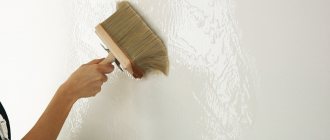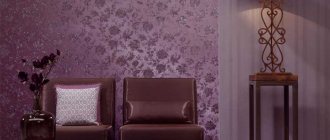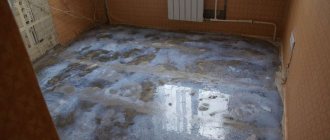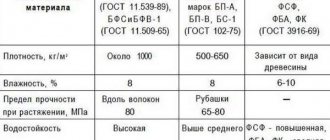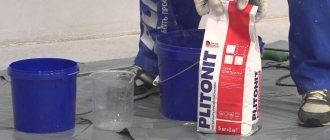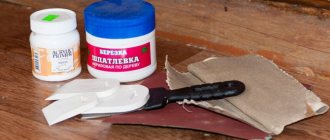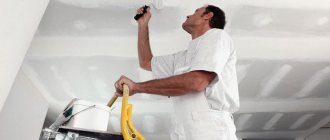Processing plywood before painting
Before painting, plywood must be completely cleaned of dust and small sawdust. Plywood sheets should be painted along the wood grain.
Do not forget that before preparing plywood for painting and staining, the sheet must dry thoroughly. Everyone knows the property of this material - to warp. You can avoid the risk of deformation by simply keeping the sheets in a dry room at room temperature for 3-4 days. This is especially true if the material was stored on the street or in a damp construction warehouse. Experts recommend not neglecting this stage and keeping the material for several days in the room where you then plan to paint it.
Initially, the sheet must be sanded to remove any irregularities. This stage can only be avoided if you purchase high-grade material. It's already quite high quality. For cheap varieties, sanding is highly desirable.
If you need to hide joints, fasteners or very noticeable defects, use putty. This material will also be useful to you if you decide to glue wallpaper onto plywood. Don't forget to sand the putty areas
After grinding is completed, the surface must be primed; most often, drying oil, primers with an alkyd base, or special compounds that fill the pores of the material are used for this.
For large volumes of work, it is recommended to use electric grinders. They will save time, make work easier and improve its quality.
What is a primer used for?
If finishing with plywood sheets is done indoors, then due to fluctuations in temperature and humidity, the wood texture may change: shrink and expand. The primer as an intermediate layer will not allow the applied paint to crack and will protect the base from moisture penetration and the formation of fungus. The primer is applied with a roller.
It is necessary to allow the soil to dry, and then additionally treat the plywood with antiseptics and fire retardants, which will enhance protection against fire and prevent blue stains from appearing. This is one of the important elements of the preparation process if you are going to paint plywood with transparent paint that has low resistance to bioaggressive manifestations.
Treatment before painting
Primer sequence diagram.
This operation is necessary for several reasons. Firstly, using a primer can prevent cracks from occurring on the surface of the wood. This is achieved due to the adhesive properties of the primer mixture. Secondly, the primer allows you to strengthen loose and porous substrates. Thirdly, it increases the wood’s resistance to moisture, as it creates a water-repellent layer on the surface of the plywood.
Ordinary plywood strongly absorbs moisture, resulting in its deformation. When priming plywood, the moisture absorption of the surface decreases, which increases its service life. This procedure is especially relevant when it is planned to treat the material with water-polymer paints or wallpaper.
Using a primer mixture, you can protect the wood not only from moisture, but also from the occurrence of fungi, mold and other organic formations. Biocidal types of primers especially contribute to this.
Features of selecting paint products
It’s not difficult to choose the right composition for painting; you just need to follow a few simple rules.
The composition should:
- Designed specifically for this coating option.
- Have the same base as the paint.
For plywood that will be installed outdoors, you should purchase a moisture-repellent compound, such as an epoxy or polyurethane primer.
Applying the composition with a roller
In fact, the process of applying the composition to the surface of the material does not cause any particular difficulties. If you are interested in the technology by which plywood is primed for painting, the video review examines the procedure for preparing the plywood surface before painting.
https://youtube.com/watch?v=ZksZEpnSaoA
Advantages of using a primer:
- The primer composition has good penetrating ability, thanks to which it saturates the wood quite deeply.
- Paint consumption is significantly reduced.
- Saves money because the cost of primer is much lower than paint.
If you are going to lay plywood on the ceiling, the sheets should be primed on both sides. If there is a high level of humidity in your room, do not forget to carefully apply the paint composition and varnish all the end zones of the slabs.
Why is it necessary to prime?
There are several reasons why it is necessary to coat a plywood base with a primer:
- Priming plywood increases the resistance of wood to the destructive effects of moisture, reduces the absorption of water by wood and prevents swelling and deformation. Subsequent coating with water-repellent paints and varnishes increases the wood's resistance to water.
- Primer and paint, which have bactericidal properties, applied to a wooden base prevent rotting.
- The primer prevents wood from cracking.
- Using a primer for painting, you can protect plywood from the formation of mold and fungal infections. This effect is achieved thanks to the commercial availability of primers with specific additives.
How to paint plywood inside a house?
The correct choice of material for processing laminated veneer sheets is the key to obtaining a beautiful and durable coating.
Acrylic paint
A water-based solution that is gaining increasing popularity. The demand is explained by the excellent characteristics of the products:
- Environmentally friendly. Unlike outdated compounds, the paint does not have an unpleasant odor and meets safety standards.
- Design potential. Most often, the solution is white, which allows you to choose the color based on the style of the room and personal preferences.
- Easy to apply. The work is carried out using suitable tools exclusively with your own hands.
- Durability. The technology involves painting in at least two layers, which allows you to obtain a coating with a long service life.
The undoubted advantage of the material is its waterproof effect and resistance to mechanical stress, so acrylic is suitable for all rooms.
Water-dispersed acrylic compositions do not interfere with steam exchange, and also have unique strength, so they are ideal for plywood
Water-based paint
This option is an alternative to the previous variety. The product is recommended for all surfaces.
Advantages of the mixture:
- Good resistance to temperature changes. The solution can be used not only in a house or apartment, but also in the country.
- Non-toxic. The water base is completely safe for others and has no lasting odor.
- Possibility of quickly changing the coating. The painted surface can be treated with different types of decorative compounds.
Working with water-based emulsion at home is easy; no special preparation of the mixture is required.
Most water-based paints are white because it is considered neutral and tinted best
Varnish
The use of this solution increases the protective properties of plywood and preserves its natural texture.
Types of composition:
- Alkyd. Suitable for exterior and interior use. It has good adhesion to the surface; the coating may have a brown tint. It takes about 72 hours for the first layer to dry completely.
- Nitrolac. A universal variation, great for processing plywood. A significant advantage of the material is quick drying (no more than an hour). The resulting film is completely transparent.
- Epoxy. The resulting surface has a high level of wear resistance, but working with the mixture requires certain skills.
- Polyurethane. The best option for plywood, transparent film reliably protects the material from harmful effects. It takes 12 hours for the first layer to dry.
Synthetic varnishes are highly durable and have good resistance to moisture, but they form a hard film that does not allow air to pass through.
Varnishing can be supplemented by other methods:
- Adding powder dye in two shades. In this case, kneading is carried out partially to achieve a “wood-like” effect. This solution is optimal when working with both uncoated and laminated material, which is previously sanded to a matte finish.
- Coating with stain to give the desired shade. But when working with glued veneer boards, the result may be unexpected. So, if you cover birch plywood with a solution, then after drying the shade will change due to the content of certain substances in the wood. Therefore, it is recommended to experiment in advance.
The stain should be purchased taking into account the type of future paint or varnish, otherwise if the base does not match, rejection will occur and the coating will simply peel off
To obtain a deep glossy effect, the surface must be varnished in several layers, followed by sanding.
Rating of the best primer brands
Primer mixtures today are produced by many brands. Their range includes products that can be used for application to plywood:
- Pufas - the brand offers a universal composition that is characterized by excellent vapor permeability. It can be used for finishing external and internal surfaces. The soil is perfect for rooms with high air humidity. It can also be used for processing facades. The composition contains fine quartz sand, which creates a rough substrate and increases the degree of adhesion.
- Pinotex Base – intended for application to wooden facades and plywood sheets. This soil spreads evenly. In addition, it contains fungicidal components that provide reliable protection against wood rotting and the appearance of fungi. It takes 1 day for the coating to dry. After its application, a matte decorative film appears on the surface.
- Tikkurila Valtti Expert Base - this Finnish brand offers a primer that is perfect for applying to plywood and wood. The material is characterized by excellent penetrating properties. Thanks to this, it allows you to treat surfaces whose humidity reaches 40%. The substance helps to equalize absorption. After which the paint applies evenly and does not form stains. The material contains fungicidal substances. They provide reliable protection against fungi, rot, and mold.
Classification and characteristics of soils
As a rule, all priming materials contain film-forming substances (polymers, adhesives, oils, special additives). Each manufacturer creates its own primer formula:
- introduces fillers into it that provide rapid drying, viscosity and other special properties;
- adds coloring pigments;
- filled with bactericidal additives.
Depending on the base, the composition can be oil, alkyd, acrylic, or mineral.
During operation, surfaces treated with different primers demonstrate different characteristics and qualities.
Therefore, before purchasing a primer, it is important to determine what properties the surface should have in the future:
Acrylic
This primer is made on the basis of acrylic, and therefore it demonstrates the best qualities inherent in acrylic paint and impregnation. Dries quickly and has no toxic odor. Acrylic primer forms a protective film and penetrates into the pores and cracks of wood, providing additional mechanical protection to the surface of the base. These properties can be enhanced by painting, for which paint materials compatible with the primer are used.
Alkyd
Excellent application on untreated plywood. Forms an ideal coating on wooden surfaces. The resulting film not only strengthens and protects the base, but also allows subsequent smooth application of paints and varnishes. Alkyd materials are excellent impregnations. They can be applied in one or more layers as desired. Alkyd primers take much longer to dry than acrylic primers and have a strong toxic odor.
Polyurethane and epoxy
Made on the basis of epoxy resin and polyurethane. Before using them, you should carefully study the instructions for use.
https://youtube.com/watch?v=ZksZEpnSaoA
Shellac
This is the best primer for covering wooden surfaces. Can be used as an impregnation before applying varnish. For production, the milky juice of insects is used.
Phenolic
Most often used for primers of plywood and other wooden surfaces in the furniture industry. They are distinguished by high impregnation ability and low price. On average, it takes 10 hours to dry completely. The disadvantage is that the phenol contained in the primer is unsafe for human health.
Drying oils
Due to its high ability to protect the surface from liquids and impart water-repellent properties to the base, it is used for external and internal finishing works.
Styrene
Promote the formation of a film on the surface of the plywood. Excellent protection of materials from rotting and mold. Compatible with alkyd and phthalic enamels.
Nitrocellulose varnish
This varnish is used as a primer intended directly for woodworking.
Selecting a primer for a plywood base is not difficult. The main thing is to take into account the characteristics of the premises and the purchased building material.
How to choose a priming material
Before purchasing a primer suitable for treating plywood surfaces, you need to pay attention to the following properties of the primer composition:
- It is necessary that the selected primer is intended specifically for impregnation of plywood and wood.
- The primer must be compatible with the paint.
- It is better if it is soil with special antibacterial additives, then it will be able to protect the surface of the wood from rotting, mold and fungal formations.
- If the surface to be treated is located outdoors and will subsequently be exposed to direct sunlight and precipitation, then pay attention to primers that have water-repellent properties.
- A soil with water-repellent properties will have to be used in any case if all other building materials used during construction have such qualities.
- The same composition as for chipboard is suitable for treating the surface of plywood - the material will increase adhesion to the base and paints.
- When choosing a primer, it is necessary to take into account the degree of humidity in the room.
- It is better to use alkyd or water-acrylic compounds for priming plywood.
- You can use nitrocellulose paints NTs-1227 or NTs-48 as a primer.
Properties of plywood
Classification of plywood involves division by grade, mechanical characteristics, elasticity and moisture resistance. A letter marking for the material has been developed, which must indicate the type of glue used to impregnate and secure the veneer during the production of the product.
Plywood characteristics:
- In the Russian Federation, standards provide for the production of plywood of the following sizes (in millimeters): 1525x1525, 1220x2440, 2440x1220, 1250x2500, 2500x1250, 1500x3000, 3000x1500, 1525x3050 and 3050x1525. The thickness of plywood sheets can vary between 3 and 30 millimeters.
- For the production of plywood, birch or coniferous trees (pine, spruce, larch) are used. The veneers are glued together perpendicular to the location of the wood fibers.
- Each type of product is assigned a specific label: FSF, FBA, FSF-TV, FB, FC, BS and BV.
- The following grades are suitable for puttying purposes: FSF, FSF-TV, FK, FB and BS. The fact is that these products are characterized by increased moisture resistance, which is an indispensable condition when selecting a material suitable for puttying.
- Plywood is also classified according to the degree of processing. Laminated and non-laminated varieties are available. Products polished on one side are marked as Ш1. Double-sided grinding is reflected in the marking Ш2. If the slab has not been sanded at all, it is marked as NSh. Of all the listed varieties, unlaminated and unsanded plywood is most suitable for puttying.
Preparing for work
The plywood sheet can be sanded or unsanded, or it can also be laminated, therefore, taking into account the characteristics of the material, some preparation steps can be skipped. Let's look at the procedure for working with a simple unsanded sheet.
Primary grinding
If you plan to simply paint, then you can limit yourself to sanding with coarse sandpaper, running it along the wood fibers
In the case when a decorative element will be made, it is also necessary to sand across it, paying special attention to the edges: sand them several times, achieving the smoothest possible surface. Grinding of cuts is carried out from the center to the edge
If you do the opposite, delamination of the veneer may occur.
Padding
This stage is very important, and it can only be skipped if the laminated product is varnished, but even in this case it is advisable to process the cuts. The primer will evenly fill all voids and microcracks in the plywood sheet and extend the service life of the product.
Particular attention should be paid to the edges, because they consist of thin wooden plates with an adhesive layer between them, which means this place is most vulnerable to moisture. The primer is applied to the edges in 3-4 layers.
Is it possible to do more? It is possible if it is intended to be used outdoors or the primer was not applied very evenly the previous time. The better the priming, the higher the protection from external adverse conditions.
Drying
Drying is necessary after each application of liquid formulations.
Plywood is very hygroscopic, and to increase its moisture resistance, drying after each treatment is very important. If you apply the following composition to undried soil, this may disrupt its protective properties.
Puttying
If there are large cracks or dents on the plywood base, they are smoothed out using wood putty. You can completely cover the entire base with putty - this will give additional strength. The sheet painted with putty is thoroughly dried again.
Re-leveling (sanding)
After applying the putty, especially if the entire base was covered with it, small “waves” could appear. When you plan to apply one color scheme, this step can be skipped, but it is not advisable: barely noticeable irregularities will be visible when bright light hits them. Sanding is carried out with fine-grained sandpaper until the required smoothness is obtained, and after completion of the work it is necessary to remove all particles of dust.
How to make plywood moisture resistant with your own hands
To impart the desired characteristics, various methods are used, involving the use of special impregnations.
Painting with nitro enamel
This is an effective method that ensures a surface that is resistant even to direct contact with water.
Process diagram:
- All sides of the sheet are sanded using abrasives with a coarse and medium structure.
- The surface is completely covered with drying oil; the ends need to be soaked especially well.
- The paint is diluted to a liquid state and laid evenly on the dry slab. The composition acts as a primer, creating a reliable basis for future work. It is recommended to paint in 2–3 layers. It is taken into account that the last coating should have the smallest thickness.
- As additional protection, fiberglass impregnated with nitro solvents is used. The canvas is glued to the entire area of the panel, but only after the first layer of paint.
Nitroenamel dries completely in a couple of hours, but this paint has a strong and pungent odor of solvent, and it also needs to be applied at least 2-3 times, since the composition is strongly absorbed. The technology
allows the use of similar compositions that are marked as moisture resistant.
Impregnation with drying oil
This solution is one of the most common and most accessible. At home, the oil is used as an antiseptic and increases the durability of the product. Processing is carried out according to the following algorithm:
Prepare a suitable container, roller and brushes. The drying oil is mixed well and poured into the container
The composition heats up to a temperature of 60 degrees. Care must be taken, because the material is flammable. All plywood sheets must be treated with the prepared solution. It is important to thoroughly saturate each area, paying special attention to the edges. The surface is forced to dry. To do this, it is advisable to use a hair dryer with power adjustment. The drying oil is heated, the entire processing cycle is repeated. The mixture must be applied until it stops being absorbed.
Natural types of drying oil have a high price, so most often plywood is treated with semi-natural compounds called oxols
The resulting coating not only is resistant to dampness, but also destroys mold and mildew.
Coating with PVA glue
This impregnation for plywood is recommended for use when additional protection against rotting is necessary, which is especially important for floor coverings.
The polyvinyl acetate composition is used to treat the slabs in a similar way: application is carried out sequentially on both sides until the surface stops absorbing the solution, special attention is paid to the ends. The main difference from the previous method is that forced drying cannot be performed.
In addition, the entire complex of work will require at least 7 days, since the film takes quite a long time to form
The main difference from the previous method is that forced drying cannot be performed. In addition, the entire complex of work will require at least 7 days, since the film takes quite a long time to form.
To treat plywood to protect it from rotting, it is not necessary to use glue; dispersed compositions based on PVA with the addition of an antiseptic work much better.
How to paint plywood
Painting plywood correctly is not difficult. We have already talked about applying paint according to the arrangement of the fibers. You can also take a completely traditional tool: a roller, sprayer or paint brush.
Let's consider in which case it is more appropriate to choose each of these options:
- Spray
Ideal for saving time and large amounts of space, such as floors, ceilings, facades;
- Roller
Convenient for painting medium-sized areas, such as a plywood cabinet, for example. As for the material of the roller coat, it is better to choose foam rubber for plywood;
- Paint brush
A universal tool that can be found in every home. Ideally paints hard-to-reach places (corners), ends and shaped elements.
Coloring
The layer is applied evenly to the surface, and it should be thin. Otherwise, you risk getting smudges, which will undoubtedly spoil the appearance. In addition, a thin coating gives the paint a richer color.
Applying varnish
Sometimes varnish is used instead of paint. The plywood is first cleaned and sanded using sandpaper or a sanding machine, then it must be cleaned of any accumulated dust and degreased. Otherwise, all dirt will be visible under the varnish.
If you want to get a glossy surface, you need to apply another layer of varnish on top. This time it is advisable to apply it using a sprayer to evenly distribute the varnish composition.
The nuances of painting white
To paint white or any other light color, you should add similar dyes to the primer, thereby achieving the required color concentration.
Wood painting
To paint plywood to look like wood, you can use different shades of stain. If you need a glossy surface, apply an additional layer of varnish on top.
How to avoid surface imperfections?
Pasting wallpaper onto plywood will not be the easiest solution, despite the availability of materials at a price. Let's look at the most common surprise that may await us. The most dangerous enemies in our event will be the joints between the sheets . If you are just planning to make walls from plywood, then try to ensure minimal differences in height at the joints. To do this, select a high-quality batch of material from a good manufacturer and level the walls as much as possible before covering; it should not necessarily turn out beautiful, but it must be even, then the sheets will lie well.
If, however, you have already received the walls where the problem described is present, then we will try to solve it. Buy serpyanka from a hardware store. This is a special fiberglass construction tape typically used to seal cracks to prevent further enlargement in the future. But in our case, it will perfectly close the joint and make it possible to apply putty to even out the differences, then you should sand it, achieving an almost perfect surface.
After all, wallpaper, especially paper wallpaper, will highlight every seam if it has any flaw, and especially height differences.
Processing methods
Processing plywood and protecting it from moisture can be done in several ways. Here are some of them (the most common in everyday life):
- puttying with PVA glue;
- coating with drying oil;
- treatment with nitro paints;
- gluing fiberglass.
Next, we’ll take a closer look at the best way to process plywood and how to do it correctly.
PVA
Protecting plywood from moisture and rot with PVA putty has many advantages. It reliably protects the material from many negative factors. Here are step-by-step instructions on how to complete the protection process:
- Before treating the material to increase moisture resistance, it is placed parallel to the floor and a layer of PVA glue is applied.
- Allow time for the initial layer to be well absorbed, after which it is covered with another layer of PVA.
- Continue the process until glue stains begin to appear on the underside of the sheet.
- The plate is turned over and the impregnation process is repeated.
After the work is completed, the slab is laid on a flat surface and allowed to dry under natural conditions. The disadvantages of this process include rather long processing times. Plywood will have to be protected from moisture for 3-4 days.
Drying oil
Drying oil is the simplest way to impregnate a plywood board from water. Processing is carried out in the following way:
- The solution (oil for plywood) should first be heated to a temperature level of 600C, due to this its penetrating ability increases.
- Then we impregnate the horizontally located sheet with drying oil using a brush.
- After completing the impregnation process on one side, we proceed to the other.
- Be sure to thoroughly coat the ends of the plywood.
- When the first layer is applied, we begin to force-dry it using an iron or hair dryer.
- After drying is completed, we begin the repeated process of applying drying oil and forced drying.
The number of layers may vary. Stop treating with drying oil only when the solution stops being absorbed by the material (the water-repellent effect is fully achieved).
Fiberglass
You can also protect plywood with fiberglass, but to do this you need to use waterproof varnishes that do not contain epoxy or polyester resins. The protection technology consists of the following steps:
- The sanded plate is painted with varnish.
- After allowing the applied layer of varnish to dry for about two hours, fiberglass is glued onto the surface of the plywood.
- Re-apply a layer of varnish to the ends of the slab and leave until completely dry.
- The treatment is completed by applying another layer of varnish and drying the impregnated plywood under natural conditions.
Nitropaint
Another way to treat plywood from moisture is with nitro paints. This is especially true when the material will be in direct contact with water, for example, when repairing a boat or arranging a damp room.
Here are instructions for doing the work yourself:
- Initially, it is necessary to sand the surface and cover it with drying oil.
- Allow the drying oil layer to dry completely and apply liquid paint as a primer.
- Apply a layer of nitro paint to the sheets protected with primer.
- We cover the surface of the plywood with a cloth, which at the same time must be impregnated with nitro solvents.
- After drying is completed, it is treated a second time with diluted nitro paint. The resulting moisture-resistant material is even suitable for making a boat.
How to glue wallpaper correctly
If the surfaces are well prepared, there will be no problems with wallpapering. During the work you will need the following:
- glue;
- container for diluting the mixture;
- pencil;
- brush;
- roller;
- scissors;
- clean napkins.
Clear the room of trash and unnecessary items. Prepare the adhesive solution by reading the included instructions. Proceed to measuring surfaces and cutting canvases. Mark a vertical line on the wall using a building level.
Now, using a roller or wide brush, apply glue to a section of the wall wider than a strip of wallpaper. If necessary, distribute the solution over the piece of fabric using movements from the center to the sides.
The gluing starts from the ceiling along the marked line. Press the strip firmly against the wall, eliminating excess air and adhesive. The following cuts are placed close to each other, and not overlapping, this will help make the joints invisible. Coat the edges well so that later they do not move away from the wall.
The coating on a plywood board will dry faster than on another base. Please take this into account when gluing so that the quality of the finish does not suffer. It is advisable to apply the first layer of glue to the wall in advance - the day before the repair. After completing work for a day, ensure that there are no drafts in the room.
Primer - protection
What is the point of priming if many types of plywood are moisture resistant and even have increased moisture resistance? And if they sold you bakelite material at a reasonable price, then you don’t have much to worry about. But as practice shows, not everything is so simple!
Photo of a possible solution.
It looks like a vicious circle, but in this case it is the primers that save you from moisture; they create a water-repellent layer on the surface of the material, as a result the veneer does not come into contact with moisture.
Besides:
- . Let us remind you once again that veneer is a layer of natural material obtained from birch logs or conifer logs. Like any wood, untreated veneer can crack when dried. Primers provide additional adhesion to the fibers;
- , such as wallpaper glue or complex paints and varnishes;
- – fungus and mold.
Combined solution.
A simple process is not entirely simple
It would seem that it would be difficult to take a primer for plywood, a brush or a roller and evenly apply the composition in accordance with the recommendations on the packaging onto the plywood product itself. But before all this is done, the plywood needs to be prepared.
Preparation is carried out with the aim of:
- Leveling the entire surface of the product, eliminating possible defects, especially in low-grade material. Filling of defects is carried out with a special wood putty. The whole process is simple, you can do it yourself, but it is mandatory.
- Sanding the entire coating into a single monolith, devoid of even minimal flaws. This stage is performed with coarse sandpaper. The grinding movement goes across the fibers of the material, finishing sanding is carried out with fine-grained sandpaper - zero, but along the fibers. It is the multidirectional movements of the abrasives that achieve the maximum effect of sanding wood and final preparing the surface for painting.
Sanding can be done not only by hand.
Now you can begin to select primers and directly apply them to the material.
Selection of primers
How to prime plywood before painting largely depends on where and for what purpose you are using the material or products made from it, as well as what kind of paint or topcoat you are going to apply or glue.
We list some recommendations that will be useful to you when choosing a composition:
- when choosing a composition, make sure that it is suitable for plywood and also has the same base as the paint that you are going to apply to the product;
- if the surface to be treated will be located in a room with high humidity, for example, in a summer kitchen, or simply in the kitchen, then the primer must meet two requirements at once - be an antiseptic for the wooden surface and at the same time protect from moisture;
It is important to know what the composition is intended for
Recommendations for coloring
Melange palette.
The plywood is prepared, primed and even dried, all that remains is to apply paint.
- Acrylic paints are best suited for residential areas, as they dry quickly, do not have strong odors and are practically harmless.
- Enamels also dry quite quickly, but unlike the former, they have a pungent odor and a pronounced toxic effect, and are used for painting products outdoors. They can be brought indoors, but after final drying.
- Additional varnish coating is allowed, since the primer + paint have already created the necessary protective layer for the coating. The only condition for application is that the painted surface is completely dry.
https://youtube.com/watch?v=ZksZEpnSaoA
What types of plywood can be varnished
Nowadays, approximately 20 varieties of plywood materials are manufactured. Each of this type, depending on its weight and characteristics, is used in some area, for example, furniture production, automotive manufacturing, roofing work, during repairs, monolithic construction, interior design, as well as during the production of containers. Many types of plywood are used only during the production of any product, and are not used in domestic conditions. The most popular varieties that are used in everyday life by amateurs and professionals are the FK and FSF brands.
FC is an environmentally friendly, natural plywood board that contains a minimal amount of chemical impregnations, so this material is vulnerable during operation. FC plywood is often used in the repair industry; it is used for the following purposes:
- for insulation, cladding and leveling of wall surfaces;
- creating a soundproofing layer of the ceiling;
- production of floor bases, that is, subfloors for laying laminate, parquet, linoleum or boards;
- creating various partitions, as well as false walls;
- beautification, renovation of the under-roof space.
The FC brand has virtually no protection against moisture, so coating the plywood with varnish is simply necessary. And FSF plywood boards have an increased resistance index, so they are most often used to create exterior finishes. These boards have a high level of wear resistance and strength; they are used for the production of laminated plywood sheets, and therefore require less varnish treatment.
Carrying out preparatory procedures
A plywood floor is varnished after a whole series of preparatory work has been carried out to improve the quality of the result.
Sequence of preparatory work:
- Processing plywood with abrasive paper (80).
- Application of acrylic primer.
- Drying.
- Treatment with putty (acrylic-based composition).
- Drying.
- Treatment of the coating with abrasive paper (80-120).
- Application of primer composition.
- Drying.
- Coloring.
Of course, you can omit all this work, but if you want the plywood under varnish to be reliably protected from moisture and fungal development, you need to apply a layer of acrylic primer.
The alkyd primer is applied to the surface with a roller, after which the plywood is painted with an alkyd or acrylic paint.
Surface grinding
As a result of leaving out several preparatory steps after painting, structural relief protrusions may appear on the floor surface. If this doesn't bother you, then you can do it that way. In rare cases, you may want to use just a primer and paint.
Painting plywood with varnish requires pre-treatment of the surface with sandpaper. Coarse-grained ones, for example 80-120, are also suitable for these purposes. Thanks to this procedure, you will be able to eliminate unevenness and defects, and the surface of the plywood will be fully prepared for subsequent processing.
Movements during the sanding process should be perpendicular to the texture of the plywood. And in order to finally level the surface, you should then walk with fine-grained sandpaper along the structural fibers of the material. After sanding, the plywood sheets are coated with an acrylic primer.
Primer and putty are necessary in order to:
- level the absorbent coating of the plywood;
- get rid of internal cracks on the veneer surface;
- increase the service life of the material;
- protect the plywood from damage.
Coarse sandpaper
Painting plywood
When the question arises of how to treat plywood from moisture, experts advise covering it with varnish or paint. These materials definitely extend the life of the plywood sheet by an order of magnitude. To carry out high-quality work using paint, you will need:
- sandpaper;
- putty;
- primer for plywood;
- brush, roller or spray;
- putty knife;
- paint for plywood.
Paint selection
To maximize the service life of a coating made from this material, consider the following recommendations when choosing a treatment solution:
- The paint perfectly copes with the water-repellent function and improves the appearance of plywood.
- If you intend to install plywood sheets in a residential area, choose water-based paint for them. It does not have a pronounced unpleasant odor, dries quickly and is easy to apply.
- If you will be working in an open space, enamel wood paints are better suited for this purpose. You can purchase any of them either in finished form or in concentrated form, which are intended for self-tinting.
Dyeing technology - method 1
A complete painting technology consists of several stages:
- Use sandpaper to sand the plywood until smooth.
- Apply acrylic primer with a roller or brush.
- Let dry for several hours.
- Putty the surface, eliminating all microcracks.
- Leave the sheet until the putty is completely dry.
- Sand, removing any unevenness caused by putty, to a smooth base.
- Carry out priming work again.
- Take a technical break until the solution dries completely.
- Prepare the paint if you are tinting it yourself.
- Paint the plywood sheet.
Paint selection
Paint for plywood is selected based on the conditions in which the sheets are intended to be used.
Water-based acrylic paint
If the building material will be installed in a residential building (apartment), then you can take a closer look at water-based paints, which are suitable for interior decoration.
The use of acrylic paint is widespread: it is environmentally friendly, easy to handle, quite durable, and also allows the use of a wide range of shades. The paint is applied to the plywood in two layers, and both sides and ends are treated. If there is no active mechanical impact on the sheets, then the choice can be made in favor of conventional water-based paint.
Facade paint
Pentaphthalic enamel is perfect for finishing facades. It is attractive not only for its low cost, but also for its durability. This type of paint, like acrylic, dries quickly. However, this type has a small drawback in the form of a specific odor, which, in fact, should not become an obstacle for external use.
In general, you can choose any paint suitable for wooden surfaces.
